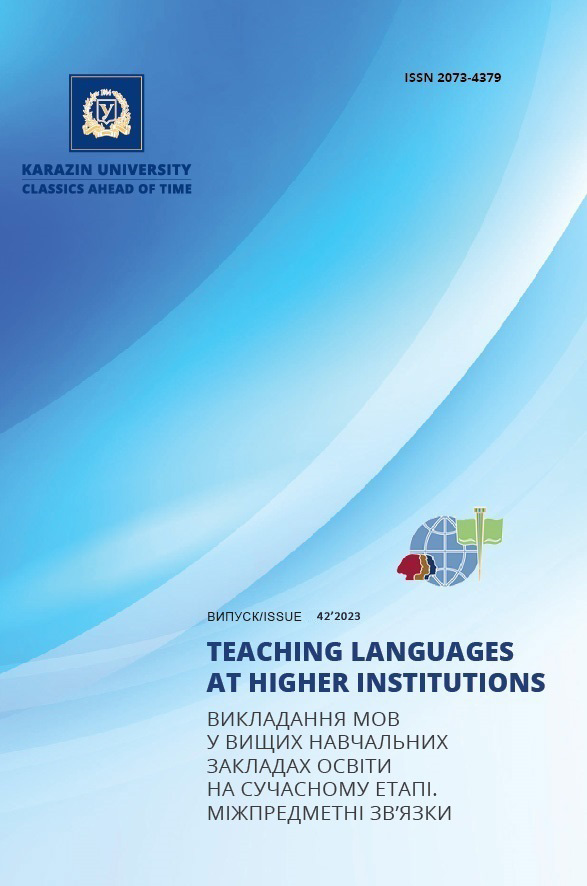Ways of integrating clip thinking phenomenon into the process of foreign language teaching in higher education institutions
Abstract
The article is dedicated to identifying the essence of the phenomenon of “clip thinking” of students as a new cognitive reality in the modern information-driven environment. The author presents the features and key prerequisites for the emergence of the phenomenon and analyzes its main positive and negative characteristics. In the context of foreign language learning, “clip thinking” may cause certain cognitive difficulties in the selection of the main aspects of long scientific and technical texts, retelling, monologue speech, or mastering certain grammatical topics.
Educators, in their professional activity, should take into account the specifics of information assimilation by modern youth, which requires rethinking educational policy and searching for innovative didactic tools. One of the approaches aimed at integrating clip thinking into the process of foreign language learning is the method of visualization which promotes quick and efficient assimilation of the material and increases the efficiency of the educational process by taking into account the distinctive features of modern youthʼs thinking patterns. In this regard, the task of the teacher is to create and use visualization that not only complements verbal information but also acts as its carrier, which contains the elements of problematic nature and minimizes the negative effects of clip thinking.
The article outlines the basic principles of infographics implementation in the process of foreign language acquisition in higher education institutions. It was found that its use optimizes the educational process, ensures its dynamism and stimulates the cognitive effect, helps to increase the motivation of “visual” students, and makes learning more meaningful. Infographics help students to interact continuously with educational content and to gain more in-depth visual information analysis and comprehension skills. The article specifies the use of mind maps as another form of visual data representation that contributes to the learning of lexical and grammatical material, analysis of professionally oriented texts, organizing information, and development of creative thinking. It is noted that the problem of training teachers to elaborate an interactive learning environment based on visual tools is a promising area for further scientific research.
Downloads
References
Bakhtina, H.P. (2011). Informatyzatsiya suspilstva ta problema “klipovogo myslennya” [Informatization of society and the problem of “clip thinking”]. kpi.ua. [online]. Available at: http://kpi.ua/1102-7 [Accessed 15 Jan. 2023] [in Ukrainian].
Berezhneva, I. (2021). Some aspects of using visualization method during teachinga foreign language in a military higher education institution. Current issues of humanities, 35, part 1, pp. 203–208. DOI: https://doi.org/10.24919/2308-4863/35-1-32 [in Ukrainian].
Hych, H.M. (2016). “Clip” thinking of young people: friend or foe training? Scientific works of Petro Mohyla Black Sea State University complex “Kyiv-Mohyla Academy”]. Pedagogy Series. 257, Vol. 269, pp. 38–42 [in Ukrainian].
Kairo, A. (2017). Functional Art: An Introduction to Infographics and Visualization. Skakun, R. (Ed.). Lviv: Vуdavnytstvo Ukrayinskoho Katolytskoho Universytetu [in Ukrainian].
Sobolieva, S.M. (2019). Clip thinking as a socio-psychological phenomenon and its role in the educational and cognitive activity of students. Theory and Practice of Modern Psychology. 3, Vol. 2, pp. 86–90. DOI: https://doi.org/10.32840/2663-6026.2019.3-2.16 [in Ukrainian].
Udovytska, T.A. (2013) “Clip thinking” of youth: peculiarities of manifestation in the learning process (stating the problem). Higher Education in Ukraine: theoretical and scientific-methodical journal of the Institute of Higher Education of the National Academy of Pedagogical Sciences of Ukraine. 31, Vol. VIII (50), pp. 407–416 [in Ukrainian].
Rosen, L.D. (2007). Me, My Space, and I. Parenting the Net Generation. New York: Palgrave Macmillan.
Smiciklas, M. (2012). The Power of Infographics: Using Pictures to Communicate and Connect with Your Audience. Indianapolis, IN: Que Biz-Tech.
Toffler, A. (1989). The third wave: The Classic Study of Tomorrow. Westminster, Maryland, USA: Bantam.

